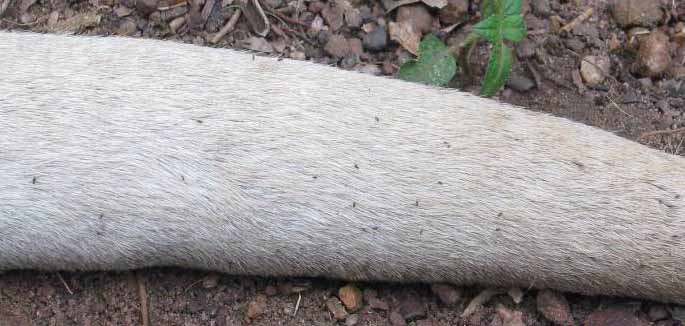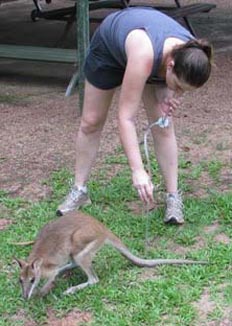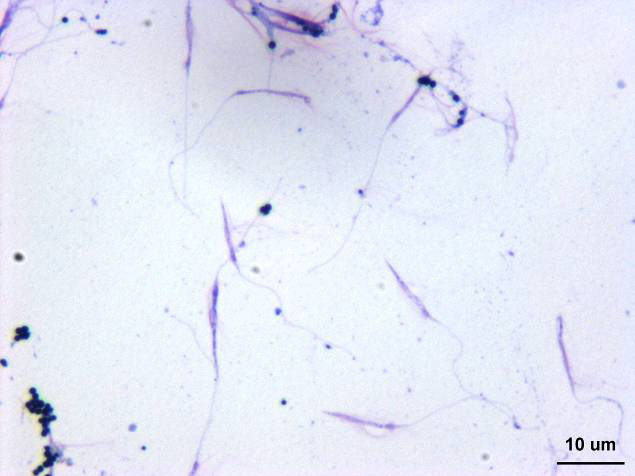Download
| Document | Pages | File size |
|---|---|---|
Field Surveillance and Monitoring – Leishmania in the Northern Territory PDF  | 7 | 227 KB |
If you have difficulty accessing this file, please visit web accessibility.
Online version
INTRODUCTION — Project Summary
Background
The Leishmania species are single–celled, flagellated protozoan parasites. The life cycle of Leishmania involves a vertebrate host and a transmitting phlebotomine sand fly vector. Disease can manifest in a number of different forms, these include skin lesions known as cutaneous leishmaniasis, destruction of the soft cartilage of the nasal septum known as mucocutaneous leishmaniasis, or systemic infection of the liver and spleen known as visceral leishmaniasis.
In 2003, locally acquired Leishmania infections were identified in red kangaroos in the “Top End” of the Northern Territory. Prior to this, Australia and Antarctica were thought to be the only continents free of endemic Leishmania and suitable phlebotomine sand fly vectors With the support of WEDPP funding, we demonstrated that the species of Leishmania infecting the kangaroos was a novel species, not found elsewhere in the world. This surprising result led to further work aimed at investigating the Australian Leishmania species and its transmission.
The lifecycle of Australian Leishmania was investigated from 2006—2009 as a PhD research project at the Menzies School of Health Research. PhD candidate Annette Dougall identified new cases of cutaneus leishmaniasis in macropods, developed and refined diagnostic tools, conducted surveillance to identify potential reservoirs of infection and undertook thorough field investigations with the aim of implicating the vector. Early vector studies focused on phlebotomine sand flies, which are the only known vector of Leishmania worldwide. In total 3046 phlebotomine sand flies were collected and morphologically identified and females were screened for the presence of Leishmania infection. All sand flies collected were from the genus Sergentomyia, which seems an unlikely vector due to its preference for feeding on reptiles. Leishmania DNA was not detected during PCR screening of 1818 female sand flies.
Thus the vector studies were broadened to include other blood sucking flies, such as biting midges, which are common in the area. New techniques were also employed, including aspirating insects directly from captive macropods residing in areas known to have a high prevalence of leishmaniasis. Preliminary investigations provided strong evidence that Australian Leishmania is being transmitted by day feeding midges of the Lasiohelea spp., with a prevalence of up to 15 per cent from a new undescribed species. This was the first evidence anywhere in the world of a vector other than phlebotomine sand flies transmitting Leishmania.
Project aims
The aim of this project was to further explore the ecology of endemic Australian Leishmania to provide information for accurate risk assessment regarding incursions of exotic Leishmania species, and to enhance capacity in the investigation of novel vector–borne diseases in Australia.
The project involved field surveillance of Lasiohelea to: further characterise the lifecycle of Australian Leishmania; assess the prevalence of Lasiohelea infection with Leishmania; assess the competency of Lasiohelea as a potential Leishmania vector; and to identify this poorly studied group of invertebrates to the species level. Additional diagnostic specimens were collected from mammals in the Northern Territory to identify animals exposed or infected with Leishmania sp. Data collected from this and previous work was collated in the newly developed, web–based spatial wildlife health information management system of the Australian Registry of Wildlife Health.
OBJECTIVES AND RESULTS
Field surveillance of Lasiohelea
1) Collection of Lasiohelea spp. from the Darwin rural area
Our previous research incriminated day feeding midges of the genus Forcipomyia subgenus Lasiohelea as the vector of Leishmania in the Northern Territory. Analysis of our trapping data from July 2006 — January 2009 indicated that these midges were most prevalent in rainy months of January to March. With the onset of the wet season in Darwin, midge trapping work recommenced. We re–established collection at our field site at the Territory Wildlife Park, approximately 50km south of Darwin. We also consulted with Northern Territory Government Medical Entomology Branch, and examined their insect collection data from various field sites around the urban and rural Darwin area. As a result of this work, we also established a new field site close to the Darwin urban area, at Buffalo Creek.
We employed a number of methods to maximise collection of day–feeding midges. Sticky traps were placed adjacent to or in microhabitats such as tree stumps, tree hollow and in the ceilings of animal feeding stations. Traps were left overnight and checked the following day. Two CO2 traps were assembled by attaching a billy can of dry ice to a standard CDC miniature light trap at each location every week from mid–January 2010 until March 2010. These traps were set during day light hours and checked the following day. Specimens collected using these methods were transferred to 70 per cent ethanol and transported to the lab for sorting at a later date. Specimens were also collected directly from Antilopine wallaroos by manual aspiration from the tail and lower limbs (Figures 1 and 2). Specimens collected using this method were transported live on ice to the laboratory for dissection or stored in 70 per cent ethanol for subsequent analysis.
Figure 1. Biting insects attacking the tail of an antilopine wallaroo
| Figure 2. Insect collection by manual aspiration
|
2) Screening of Lasiohelea specimens to determine if they are carrying Australian Leishmania parasites
Initially, a total of 336 female Lasiohelea collected at the Territory Wildlife Park in January were transferred individually to wells of a microtitre plate for DNA extraction. The 44 samples from Wickham Point in 2003 (Medical Entomology Branch collections — see below) were also included. DNA extractions were prepared using a non–destructive extraction method, which allows the body of the midge to be retained for further morphological analysis if required. These midges are currently being screened using an Australian Leishmania specific real–time PCR to determine if Leishmania DNA can be detected. We anticipate many specimens collected at the Territory Wildlife Park will be carrying Leishmania infection as seen from the dissections carried out below.
We also transported some midges from the field to the laboratory alive for manual dissection. Ten midges had their guts dissected and examined for the presence of Leishmania parasites. One midge, which was identified as the undescribed species of Lasiohelea, was found to be heavily infected with live Leishmania parasites. Diff–quik staining clearly showed the presence of flagellated promastigotes (Figure 3). This midge was manually aspirated from an Antilopine wallaroo at the Territory Wildlife Park field site in February 2010. Importantly, this confirms ongoing transmission of Leishmania in the Northern Territory.
Figure 3. Flagellated Australian Leishmania promastigotes
|
3) Sorting of collected specimens and identification of Lasiohelea species
Our wet season trapping work yielded collections with larger numbers of day–feeding midges and other insects than anticipated. Large numbers of mosquitoes were caught at the new Buffalo Creek field site in particular. This made the sorting of the insects and the identification of Lasiohelea within these collections from this field site extremely time consuming. Only 25 Lasiohelea specimens were found in the Buffalo Creek collections from January. In contrast, over 400 Lasiohelea were found in the collections from the field site at the Territory Wildlife Park. Higher rainfall occurred in January than February in 2010 and this was reflected in higher numbers of Lasiohelea being collected in January at the Territory Wildlife Park. The location, trapping method, parity and gravid state was recorded for each specimen.
In addition a total of 44 specimens were sorted from stored light trap collections carried out by the Northern Territory Government Medical Entomology Branch at Wickham point on Darwin Harbour during the wet season of 2003. These specimens are from a geographically distinct area and date back to the time of the original identification of Leishmania infection in kangaroos in the Top End. These specimens will also be identified to the species level and screened for the presence of Leishmania parasites.
Significantly, we have also identified four probable male specimens of Lasiohelea in these collections. The locations of the traps that yielded males may help to indicate likely breeding sites. Also to undertake a formal description of the undescribed Lasiohelea species, male specimens are required. These four specimens have been subjected to non–destructive DNA extraction and will be confirmed as Lasiohelea by sequencing the ribosomal intergenic regions. We already have the sequence data for all species found in our previous collections.
4) Carry out bloodmeal analysis of blood fed specimens
Analysis of the bloodmeals present in female insects (both phlebotomine sandflies and then day feeding midges), has proved problematic. In our initial work (PhD studies), for many of the phlebotomine sandfly specimens, no PCR product could be obtained using primers targeting the vertebrate 12S rRNA gene. For some others a product was obtained, which when sequenced, proved to be of human origin. It is likely that these specimens have become contaminated with human DNA in the process of handling for sorting, identification and DNA extraction.
Bloodmeal analysis was subsequently attempted on ten Lasiohelea that had evidence of full or partial bloodmeals. Sufficient product was obtained for sequencing from only three of the midges. Two of these were shown to be from two different macropod species, consistent with the observation of leishmaniasis in macropods. The third sequence was derived from a dog. While it is possible that midges at the Territory Wildlife Park are biting the domestic dog pets of staff, or local dingoes, none of these animals were observed in the vicinity when these specimens were trapped (using a flight trap or by manual aspiration).
Most of the Lasiohelea collected in 2010 were from traps that used CO2 as an attractant. It is likely that these midges were attracted to the CO2 as they were seeking a bloodmeal, rather than already having taken a bloodmeal. This was reflected in the very low numbers of the midge specimens sorted that were found to have a full or partial bloodmeal. These samples will be processed using a dedicated DNA extraction kit in a designated clean area to try and avoid potential sources of laboratory contamination.
To attempt to circumvent difficulties with bloodmeal analysis of specimens, we undertook manual aspiration of day feeding midges directly from macropods in the known transmission area. Day feeding midges were directly observed feeding on species of animals known to be susceptible to Leishmania infection. In some cases the Lasiohelea were observed in the process of taking a bloodmeal. As previously indicated, manual dissection of midges manually aspirated while feeding on macropods known to be susceptible to Leishmania has revealed the presence of live parasites. This evidence convinces us that the Lasiohelea species that carry the Leishmania parasites do feed on the species of animals in which disease has been found.
5) Further characterise the lifecycle of Lasiohelea
In February 2010, investigator Dr. Bruce Alexander travelled from Edinburgh to Darwin to assist with the further characterisation of the lifecycle of Leishmania parasites in Australia. He spent two weeks doing laboratory and field work, focusing on morphological analysis of the undescribed Lasiohelea species and assessing local microhabitats for potential midge breeding sites.
An attempt was made to locate the breeding sites of the undescribed Lasiohelea species in several terrestrial and semi–aquatic microhabitats at the Northern Territory Wildlife Park in Berry Springs. A number of different microhabitats were selected for examination (Table 1). Five samples, each weighing approximately 2kg, were removed and transported to the laboratory. Each sample was sifted through a plastic sieve (aperture size 5 mm) and examined under a dissecting microscope in up to 20 aliquots of approximately 100g. Each aliquot was examined for 2 minutes, with the soil being turned over with a large pair of forceps. While many different organisms were identified in the samples, no midge larvae were identified in samples from any of the microhabitats.
| Microhabitat description | Organisms seen (no. aliquots) | |
|---|---|---|
| 1 | Thin layer of moss on top of mud beside perimeter fence, “Woodland Walk”, removed using a fine–toothed garden rake. | No organisms whatsoever seen. Organisms present in 0 per cent of aliquots. |
| 2 | Leaf litter at side of path in “Woodland Walk” enclosure. | Ants (3), mites (1) seen. Organisms present in 20 per cent of aliquots. |
| 3 | Soil immediately under and surrounding wallaroo water tray in “Woodland Walk” enclosure. | Earthworms (9), staphylinid beetles (4), other beetles (1), mites (2) seen. Organisms present in 60 per cent of aliquots. |
| 4 | Wallaroo dung/soil disturbed by bandicoots at edge of path in “Woodland Walk” enclosure. | Mites (4), staphylinid beetles (2), ants (1) seen. Organisms present in 35.7 per cent of aliquots. |
| 5 | Mud at edge of puddle on dirt road. | No organisms whatsoever seen. Organisms present in 0 per cent of aliquots. |
Very little is known about the life cycle of Lasiohelea in Australia, however the presence of a proleg on the Lasiohelea larva indicates that it likely lives in a terrestrial or semi–aquatic habitat rather than water, unlike Culicoides larvae. Although no larvae of midges or any other Diptera were seen in the microhabitats sampled, there was an abundant fauna of predatory beetles, mites, ants and earthworms in three of the five microhabitats. Further work could focus on the moist soil surrounding water troughs where marsupials are bitten by midges. Other techniques such as agar overlay, sugar flotation or Berlese funnels could also be used to process larger numbers of samples.
Wildlife surveillance for natural Leishmania infection
6) Collect blood and tissue samples from native mammals in the “Top End”
The time consuming nature of the insect trapping and subsequent sorting, identification and analysis has meant that there has been little time to follow up possible opportunist blood and tissue sample opportunities. As a result we have only a limited number of new samples from native animal species. However, we were pleased to have formed a new collaboration with Dr Bethany Jackson who is undertaking a research masters through Murdoch University in Western Australia in partnership with the Northern Territory Department of Natural Resources, Environment, The Arts and Sport. She is conducting a survey of black–rats and other small mammal species in Kakadu National Park and the Darwin urban regions. While the trapping has been slightly delayed by the unusually late end to the wet season in 2010, to date she has trapped and collected blood and tissue samples from 40 individuals. She aims to have completed sampling from a total of 100 individuals by the end of July. We will also continue to collect samples contributed by existing collaborators which include wildlife carers, local veterinarians and staff at the Territory Wildlife Park.
7) Determine if collected samples are infected with, or exposed to Leishmania
Dr Jackson plans to carry out the analysis of sera and tissue samples from the collections outlined above at our laboratory at the Menzies School of Health Research using our established protocols. This is planned for a three to four week period in August 2010, after the completion of her field work. Sera will be tested for the presence of anti–Leishmania antibodies, which would provide evidence of natural exposure to the parasite. This information can be used to enhance our knowledge of the host species range and of the distribution of the disease. In addition tissue samples will be screened by our established real–time PCR method for evidence of parasite DNA, which would be indicative of current or recent infection. The same methodology will be used to examine specimens that have been received from existing collaborators during the course of the project, and includes lymph node and spleen specimens from an infected northern wallaroo and two ear tissue snips (including serum) from agile wallabies located in the Darwin rural area.
8) Collation of the data in the Wildlife Registry’s new spatial, web–based wildlife health information management system
During the initial phase of the project, our work focused on collating the data collected over the previous three years of research into the Leishmania lifecycle. This included data on insect trapping, identification and screening as well as the collection and analysis of blood and tissue samples from a variety of native mammals. A custom database was constructed at the Menzies School of Health Research and populated with the collated data. The data was then exported from this database into spreadsheet format and provided to the Australia Registry of Wildlife Health for inclusion in the web–based Wildlife Health Information Management System. All results from this project have been provided to the Registry and included in its web–based database. This will be a valuable repository of information regarding Australian Leishmania.


 Day feeding midges of the genus
Lasiohelea were manually aspirated from the tail and lower limbs of captive Antilopine wallaroos.
Day feeding midges of the genus
Lasiohelea were manually aspirated from the tail and lower limbs of captive Antilopine wallaroos. Leishmania promastigotes were manually dissected from the gut of a specimen of an undescribed species of
Lasiohelea and stained with Diff–quik ? (x1000 magnification).
Leishmania promastigotes were manually dissected from the gut of a specimen of an undescribed species of
Lasiohelea and stained with Diff–quik ? (x1000 magnification).